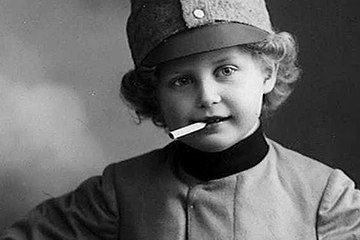Propaganda: psychological warfare in the First World War
The First World War witnessed the wholesale mobilization of the masses to an extent that had never been seen before. As in all the belligerent countries, targeted propaganda became an important element of warfare in the Habsburg Monarchy. Men and women, young and old, the front line and the hinterland, were to form a common ‘front of opinion’.
The targeted use of state propaganda took warfare onto a new level. Increasingly sophisticated technology and intense personal commitment led to professionalization of official propaganda, marginalizing public criticism and doubt. Propaganda was used to persuade the population of a particular view of the war and to mobilize the total forces of the land in support of the war aims. The political leadership invoked the unity of the state and the emotional loyalty of the people. Likewise, anybody who doubted the official version of events was stylized as a traitor to the common cause.
Propaganda was utilized to extend the reach of warfare to the population of enemy states. The aim was not merely to defeat the adversary on the battle field but to demoralize the population in the hinterland through the use of targeted propaganda. The warring powers sought to defend their position towards the neutral states, attributing guilt for the conflict to the opposing side. Each side accused the other of waging a war that broke international law.
The instruments of propaganda were varied and deployed in all the states involved in the conflict. With varying degrees of speed and professionalism they accompanied the military operations in the media, making the war tangible beyond the front. Modern mass communications meant that the radius of action could be extended considerably. Documentaries, propaganda and feature films glorified the mission of war, posters exhorted every individual to make a personal contribution to the war effort, and the postcard industry multiplied patriotic motifs and propaganda slogans. Pamphlets disseminated politically biased information, while cartoons denounced the enemy and propagated national stereotypes. Exhibitions popularized the war among the masses, heroizing the armed forces and their allies. Through the targeted use of pictorial propaganda the war became an established presence as an object of visual consumption in everyday life.
Translation: Sophie Kidd
Džambo, Jozo (Hrsg.): Musen an die Front! Schriftsteller und Künstler im Dienst der k. u. k. Kriegspropaganda 1914-1918. Begleitband zu gleichnamigen Ausstellung des Adalbert-Stifter-Vereins, München 2003
Jeismann, Michael: Propaganda, in: Hirschfeld, Gerhard/Krumeich, Gerd/Renz, Irene (Hrsg.): Enzyklopädie Erster Weltkrieg, Paderborn/München/Wien 2009, 198-209
Mayer, Klaus: Die Organisation des Kriegspressequartiers beim k. u. k. AOK im Ersten Weltkrieg 1914-1918, Unveröffentlichte Dissertation, Universität Wien, Wien 1963.
Rother, Rainer (Hrsg.): Die letzten Tage der Menschheit. Bilder des Ersten Weltkrieges. Eine Ausstellung des Deutschen Historischen Museums Berlin, der Barbican Art Gallery, London und der Staatlichen Museen zu Berlin – Preußischer Kulturbesitz in Verbindung mit dem Imperial War Museum, London, Berlin 1994
Schwendinger, Christian: Kriegspropaganda in der Habsburgermonarchie zur Zeit des Ersten Weltkriegs. Eine Analyse anhand fünf ausgewählter Zeitungen, Hamburg 2011
-
Chapters
- Propaganda: psychological warfare in the First World War
- The battle for hearts and minds.
- Friend and foe – guilt and innocence in First World War propaganda
- “Let your hearts beat for God and your fists beat the enemy”
- The First World War as reflected in the distortions of caricature
- The war on the wall
- Truth from the clouds
- The Emperor’s Voice
- Tones and Sounds






